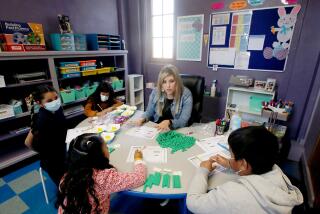How Peg + Cat can be a math class during coronovirus school closures
- Share via
One form of distance learning can be as easy as turning on a low-tech tool — the television.
In a partnership designed to provide students and parents — especially low-income households without Wi-Fi access — an alternative to online classes, the Los Angeles school district teamed up with PBS SoCal/KCET and San Francisco’s KQED to offer a slate of educational programming.
For the record:
10:59 p.m. April 3, 2020This story has been corrected to say that “Pinkalicious & Peterrific,” about the adventures of a pair of siblings, serves as a social learning lesson.
It’s popular. Two weeks into the partnership, the three stations involved were viewed by an average of 140,000 homes — and nearly 200,000 people — a day, according to PBS. More than 70 television stations across the country have picked up the LAUSD/PBS schedule, including all PBS stations in California.
With schools closed, the partnership also offers games, activities, videos and supplemental reading material for families with online access.
For pre-K to third-grade viewers, “Pinkalicious & Peterrific,” about the adventures of a pair of siblings, serves as a social learning lesson, while “Peg + Cat,” about a girl who solves word problems, reinforces math knowledge. Episodes of “NOVA,” the long-running PBS documentary series, emphasize science for grades 4-8.
For older students, Henry Louis Gates Jr.’s four-part series “Black America Since MLK: And Still I Rise” acts as a social studies class.
Before each show aimed at grades 4-8 or 9-12, PBS airs one-minute videos with prompts for each episode that are answered after the show.
“We’ve never been through anything like this before, and the goal here is just to continue learning at home,” said Andrew Russell, president and chief executive of PBS SoCal and KCET. “We’re trying to build a service so we can continue that during who knows how long this is.”
How do I watch?
The programming is spread across three local PBS channels grouped by age range. Each week’s schedule is published ahead of time here. The schedules for the week of April 6 are linked below:
- PBS SoCal airs programming for pre-K to third grade from 5 a.m. to 5 p.m.
- KLCS divides programming between pre-K to third grade from 6 a.m. to 8 a.m., grades 4-8 from 8 a.m. until 2 p.m., and grades 9-12 from 2 p.m. to 6 p.m.
- KCET airs programming for grades 9-12 from 9 a.m. to 3 p.m.
The shows are also available for streaming on the PBS Video and PBS Kids apps.
What should I expect from the programs?
For families without other options, the TV programming is meant to stand on its own.
L.A. Unified Superintendent Austin Beutner said he conceived of the PBS partnership as a “low-tech” solution for LAUSD families who might lack access to more “high-tech” distance learning tools online. “It had to be the ability to make sure, from an equity and access standpoint, we provided for all we serve, including those most in need,” Beutner said.
But families may benefit most from combining television viewing with PBS’ online resources. Children in grades 4-8 watching “Africa’s Great Civilizations” also have access to a map of the areas being discussed or an excerpt from Gates’ travel journal in Timbuktu. Students in grades 9-12 can read President Woodrow Wilson’s Declaration of Neutrality as they watch “The Great War: American Experience Part 1,” a documentary on World War I.
To receive the daily activities and links to online tools, parents and teachers can check the At-Home Learning homepage here, sign up for the At-Home Learning newsletter here or follow @KCET on Twitter.
What do teachers think?
Teachers and education advocates have praised the district for attempting to meet the needs of low-income families as schools transition to distance learning but say TV learning works best as a supplement to educator-led programs.
“I was in the middle of an earth science unit, in the middle of a chapter book, in the middle of a math unit,” said Misti Kemmer, a fourth-grade teacher at Russell Elementary School in South Los Angeles. “They can watch TV all day long, it’s not going to catch them up on the fourth-grade-level standards that I was in the middle of teaching them.”
The program caters to broad age groups across multiple schools across the country, which makes it impossible to replicate the specific lessons students were doing before schools closed, teachers said.
“Everybody’s doing the best they can,” Kemmer said. “I don’t want to criticize them for making an effort, it’s great, but it’s no substitute for the kids being in school.”A mom’s point of view
Rochelle Srigley, a single mother and freelance public relations consultant, dove headfirst into homeschooling when her daughters’ elementary school in Burbank closed last week.
Srigley is using the PBS At-Home Learning program as a supplement to the homework and teacher-assigned activities her daughters received from school. They watch “Pinkalicious” and other shows, then her daughters use her laptop to complete online activities. For pre-K to third grades, activities could be a PDF worksheet asking them to write a story, an art lesson, or an interactive game.
“The kids really like it and it’s teaching them something, but it’s fun,” said Srigley, who wrote about the partnership on her blog Rockin Mommies, aimed at single moms in Los Angeles. “It’s just another tool, basically, because you’re trying to come up with a million things to do.”
More to Read
Sign up for Essential California
The most important California stories and recommendations in your inbox every morning.
You may occasionally receive promotional content from the Los Angeles Times.











